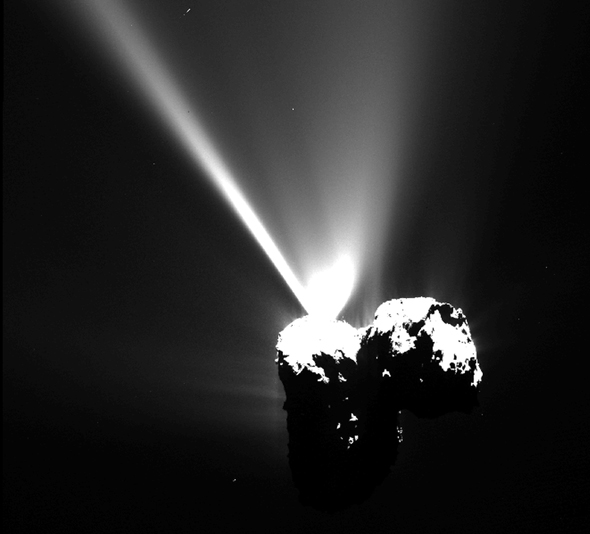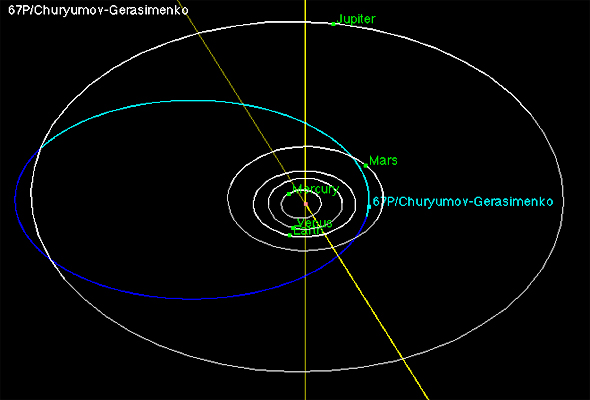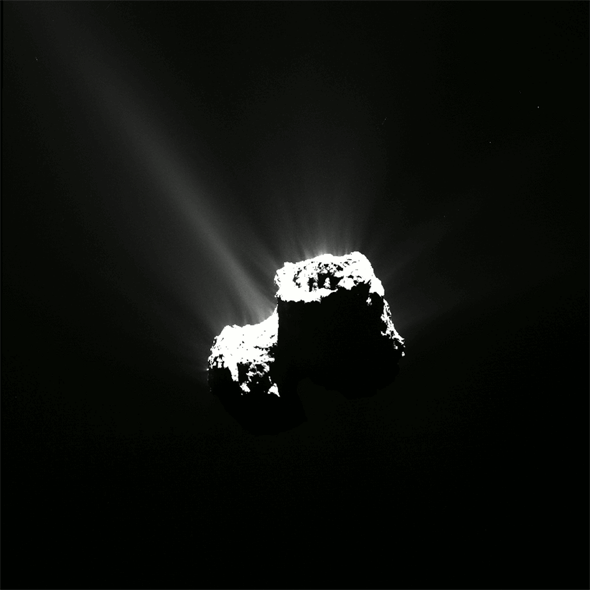A Comet’s Eruptive Day in the Sun
Thursday at 02:03 UTC, the comet 67P/Churyumov-Gerasimenko reached perihelion: Its closest approach to the Sun. At that time, it was about 186 million kilometers from our star (for comparison, the Earth is about 147 million kilometers from the Sun at perihelion).
This happens once every time it orbits the Sun on its 6½-year path, of course, but this time is special: It has a visitor. The European Space Agency’s Rosetta probe has been tagging along with 67P for just over a year now. The spacecraft entered orbit around the comet on Aug. 6, 2014, the first time in human history a machine made by us evolved apes ever achieved such a feat.
The timing was critical, getting to the comet a year before perihelion. As the comet nears the Sun, the light warms the comet’s surface. Comets are rock, gravel, and dust mixed in with lots of different kinds of ice (water, carbon dioxide, carbon monoxide, ammonia, and more), so as the ice turns into a gas from sunlight, the comet sloughs off material. This forms the tails, for one thing, but also allows the spacecraft to observe the debris and learn about 67P’s composition and structure.
Rosetta arrived in plenty of time to catch activity rising. From Rosetta we’ve seen the venting in the surface, forming pits that grow over time. The comet is surrounded by a soft aura of reflected sunlight from the gas and dust, but that’s also punctuated by more focused thin jets of material coming from vents.
But on Wednesday at 17:35 UTC, a richer pocket of gas was reached by the warmth of the Sun. It erupted, forming the more intense and spectacular jet you can see in the image at the top of this post. There’s also a fan of light next to it, which is interesting. If I had to guess—and why not—I imagine that there was a warming pocket of ice under the surface. It reached a critical point and erupted, blowing out a small amount of material as it burst through the surface that expanded to form that fan, while a smaller hole focused the outflowing material into that lovely streamer.
Here’s an animation created from several images taken before and after the eruption.
In one sense it’s no coincidence that this happened at perihelion; as the comet warms, we see more activity. Getting that bright jet right at perihelion is something of a coincidence: It’s not like suddenly the comet abruptly gets warmer at that moment! In fact, it takes time for the warmth to seep down into the subsurface regions, so I expect we’ll see more activity after perihelion than before. But who knows?
And of course that’s the point. We don’t know, and that’s why we sent our robotic proxy to the comet in the first place. Even if we’ve observed the perihelion behavior of hundreds of comets from Earth, it’s still worth examining them up close. As comet hunter David Levy says, comets are like cats: They both have tails, and they do precisely what they want. They’re individuals, and only by studying as many as we can, in as much detail as we can, will we learn about them as a whole.
In June, the ESA confirmed that the Rosetta mission will be extended at least through September 2016, so the plucky craft will be able to continue to observe the comet for over another year as it draws away from the Sun. What will it see?
I don’t know. Let’s find out.




